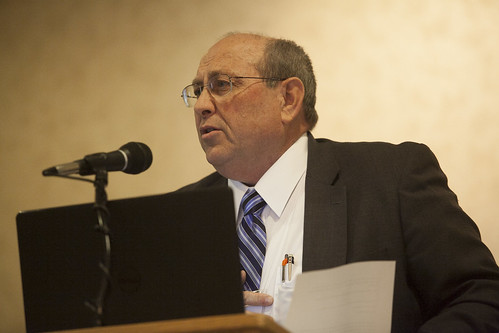Cartwright delivers keynote at Arkansas Crop Management Conference
By Ryan McGeeney
U of A System Division of Agriculture
Jan. 20, 2017
Fast Facts:
- Cartwright, other speakers emphasized importance of integrated pest management principles
- More than 400 growers, consultants and industry experts attended this year’s conference, its 49th year
- U of A System Division of Agriculture agronomists and experts provide bulk of education and information
(582 words)
(With art available at https://flic.kr/s/aHskSRYpWG)
NORTH LITTLE ROCK, Ark. — Across the broad swath of scientific disciplines on display at the 2017 Arkansas Crop Management Conference, one concept consistently emerged as a common thread: integrated pest management.
From University of Arkansas System Division of Agriculture agronomists to research scientists, meteorologists and industry experts from across the country, many of the dozens of presentations delivered during the three-day conference touched directly or incidentally on the need to comprehensively manage challenges in the field as they arise, emphasizing the need to rely on scientific data and a willingness to forgo “gut feelings.” More than 400 growers, consultants and other agriculture industry professionals attended the 2017 conference, held at the Wyndham Hotel in North Little Rock. The conference debuted in 1968.
The integrated pest management (IPM) concept, which emphasizes prevention, avoidance, monitoring and suppression in reducing or eliminating damage caused by insects, weeds, pathogens and other pests on crops of all kinds, was also the subject of the keynote address delivered Tuesday by Rick Cartwright, interim director of the Cooperative Extension Service within the Division of Agriculture, to conference attendees.
“IPM is about using all the tools we have to reduce the impact of pests on a crop and a farmer’s livelihood, and to do it in a science-based, logical way,” Cartwright said. “We try to prevent bad things from happening, use cultural and other practices to minimize the development of problems, and to keep from making things worse.
“And it is a huge deal, to monitor and scout those crops — knowing what’s out there, and knowing on the front end, so you can make informed and timely decisions,” he said. “Integrated pest management is about ‘management,’ not just reacting.”
The key to prevention — keeping pests from getting an initial toehold whenever possible — includes using clean seeds, clean seedbeds, equipment sanitation and quarantines, as well as other methods. Avoidance means employing practices such as crop rotation, resistant varieties and other cultural practices.
“Scouting effectively and properly is hugely important to the bottom line,” he said. “If you end up with a grown up mess of weeds, ‘revenge treatments’ don’t do you a lot of good. They make you feel a little better, but it’s too late. But there’s also a philosophy that, ‘if I see one weed or insect, I’m going to spray the whole farm.’ We’ve got to manage better than that.
“Looking at our current problems with resistant weeds, if we continue to overuse the same pesticides without following IPM principles, then bad things are going to continue to happen,” Cartwright said. “And of course, farmers will bear the brunt of these bad changes within the system.”
IPM concepts were promoted heavily throughout the United States through the 1980’s, but gradually fell out of favor in the since, for many reasons. The U.S. Department of Agriculture invested approximately $500,000 a year (in inflation-adjusted dollars) to conduct IPM education in the 1980’s. Today, Cartwright noted, the department spends about $100,000 each year for the same.
“Regardless of circumstances that have led us to this point in row crop agriculture, the principles of IPM are well researched, and remain valid for farm management today,” he said. “But the future of effective IPM is rooted in technology. In the near future, it really will be about drones, gene editing, computer modeling, robots and artificial editing. These technologies have enormous potential for IPM and row crop agriculture, but we need to have the wisdom and willingness to embrace them and use them appropriately.”
Pursuant to 7 CFR § 15.3, the University of Arkansas System Division of Agriculture offers all its Extension and Research programs and services (including employment) without regard to race, color, sex, national origin, religion, age, disability, marital or veteran status, genetic information, sexual preference, pregnancy or any other legally protected status, and is an equal opportunity institution.
# # #
Media Contact: Mary Hightower
Dir. of Communication Services
U of A Division of Agriculture
Cooperative Extension Service
(501) 671-2126
mhightower@uada.edu
Related Links
